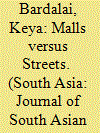| Srl | Item |
| 1 |
ID:
169996


|
|
|
|
|
| Summary/Abstract |
This paper explores the experiences of migrant women from Northeast India who work in retail stores in malls in Delhi and Gurgaon, and the conflicting discourses of modernity and marginality which they negotiate at work and outside work. Managers of high-end retail stores in malls view these women as ‘modern’, ‘global’ and reflective of the aesthetic sensibilities of the brands they are hired to sell. For this reason, north-eastern women’s bodies and identities are ‘valued’ and ‘sought after’ by retailers and recruiters. Yet, outside, especially on the streets of Delhi, the same women whose aesthetic and modern attributes are valued at the workplace are subject to racial and sexualised stereotyping that labels them as ‘promiscuous’, ‘provocatively dressed’ and lacking in sexual respectability. This paper describes the spatial practices of north-eastern migrant women as inscribed by the shifting landscapes of modernity and marginality that they must negotiate as they reconcile their different public identities in the city.
|
|
|
|
|
|
|
|
|
|
|
|
|
|
|
|
| 2 |
ID:
186829


|
|
|
|
|
| Summary/Abstract |
Drawing on interviews and focus group discussions with 26 participants aged between 10 and 17, the paper describes sexual reproductive health problems, health-seeking behaviour, access to and utilisation of sexual reproductive health services among children living on the street in Harare. An intersectionality approach showed how participants’ social location, age and gender created vulnerabilities leading to STIs, maternal complications and sexual violence among others. Additionally, these factors contributed to challenges in accessing sexual reproductive health services among children living on the street. Thus there is need for tailor-made interventions to influence better health outcomes among children living on the street.
|
|
|
|
|
|
|
|
|
|
|
|
|
|
|
|